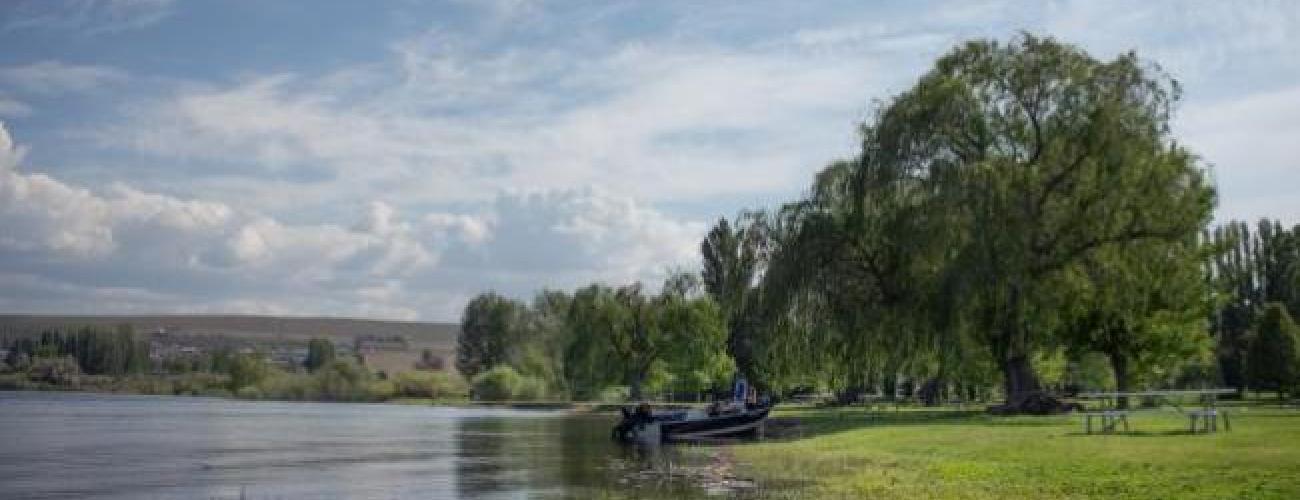Potholes State Park History
Washington’s Sand Sea
Potholes State Park is set in a unique environment dominated by ancient sand dunes and a modern irrigation reservoir.
In the final stages of the most recent ice age, masses of glacial ice repeatedly blocked meltwater drainage, creating huge bodies of impounded water in northern Washington, Idaho and Montana. When the ice dams melted or were breached by the sheer weight of water behind them, gigantic Ice Age floods swept over the landscape.
As the floodwaters burst out of the narrow confines of the Grand Coulee, the flow quickly slowed and began to deposit the load of sediments it had been carrying. Fine-grained sediments, like sand and dirt, were carried the farthest distance, coming to rest in a wide area near today’s Potholes State Park.
After the floods, predominant westerly winds lifted and carried sand and silt deposited by the water, forming parabolic sand dunes, with their distinctive horseshoe shape. The dunes, now somewhat anchored by vegetation and partially flooded by the Potholes Reservoir, cover close to 200,000 acres with individual dunes up to 50-feet-high.
Indigenous Lands
Potholes State Park lies within the traditional territory of Sahaptin language speaking Indigenous people whose present-day descendants include members of the Confederated Tribes and Bands of the Yakama Nation and the Confederated Tribes of the Colville Reservation.
Some local tribes ceded ownership of the area to the US federal government under duress in the Yakima Treaty of Camp Stevens in 1855, keeping rights to harvest natural resources in their usual and accustomed places, including the lands and waters of the Columbia Plateau.
After government land surveys were completed in 1882, the land in today’s Potholes State Park was conveyed into private ownership in 1896 as a part of the Northern Pacific (NP) Railroad Land Grant. The US Congress had approved the grant in 1864, which eventually conveyed nearly 40 million acres of public domain lands to subsidize the construction of railroad lines into the western states. Most lands were later sold to other private landowners.
Columbia Basin Project and O’Sullivan Dam
The Columbia Basin Project (CBP) is the largest water reclamation project in the United States, supplying irrigation to over 670,000 acres of farmlands through a system of reservoirs and canals. The crops grown on the irrigated land total in value more than half a billion dollars each year.
On July 18, 1918, newspaper publisher Rufus Woods printed an article touting the idea of a massive dam on the Columbia River near Grand Coulee to provide hydropower and irrigation benefits to Central Washington. Years of study and debate followed, but the idea gained real traction during the Great Depression when the administration of President Franklin D. Roosevelt authorized large public works projects to “relieve unemployment and to develop great regions of our country … for the benefit of future Americans.”
In late 1934, the first concrete was poured for construction of Grand Coulee Dam. Though electricity generation began at the dam in 1941, the nation’s preoccupation with World War II delayed completion of the irrigation components of the project. Water for the irrigation system is pumped from the reservoir behind Grand Coulee Dam nearly 300 feet up to a 1.6-mile-long feeder canal flowing into a reservoir (Banks Lake) filling the trough of the upper Grand Coulee, held by dams at both ends.
Irrigation water is distributed from Banks Lake to the northern part of the Columbia Basin Project via a system of canals and other waterways that eventually feed the return flows into the 27,800-acre Potholes Reservoir. Subsequently, water is distributed from Potholes Reservoir to additional customers in the southern part of the Columbia Basin Project. The reservoir is formed by O’Sullivan Dam, one of the largest earthfill dams in the United States, measuring 19,000 feet long and 200 feet high. The dam was built between 1947 and 1949. Water began to flow through the system in 1951, and additional components have been added or upgraded since then.
In 1955, the project supplied irrigation to 2,480 farms covering 246,800 acres. By the 1990s, fewer farms (2,050) received irrigation on more than twice as many acres (530,000).
Making a Park
The Washington State Parks and Recreation Commission entered into an agreement with the US Bureau of Reclamation on July 10, 1952, to “facilitate the highest public benefit through the development and maintenance of the recreational, wildlife and fisheries potential of the land and water areas” of the Potholes Reservoir and other components of the Columbia Basin Project.
After park facilities were designed and developed, Potholes State Park was dedicated on October 14, 1973.
Sharing the histories of Washington’s state parks is an ongoing project. Learn more here.

